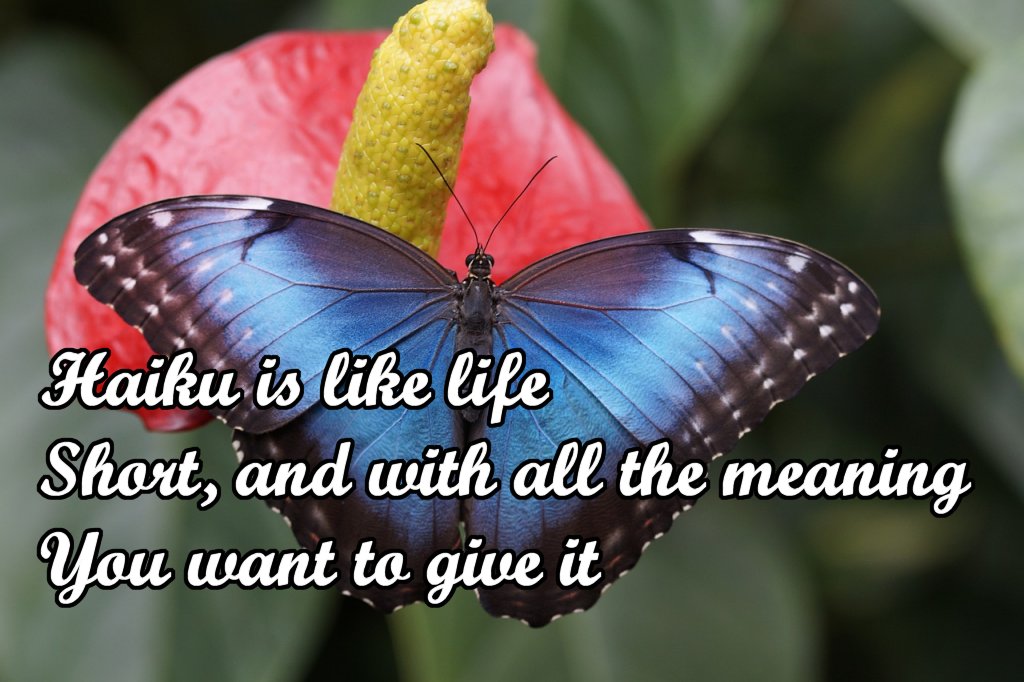Haiku – A Primer
I’ve touched on the subject of haiku elsewhere, but I thought I’d devote an entire article to it to help you better understand what it is – and how you can create your own.
I was first introduced to haiku (this is both the singular and plural form), albeit only in passing, when I was at school, so that would probably be some time around 1975, give or take a year.
And even though I immediately saw the appeal of it, I didn’t take it up until decades later, a few years after I had moved to the USA.
So, if you’ve never heard of haiku before, then this article will explain, briefly, what it is. (And if you want to learn a lot more about its rich history and the way its evolved over the years, then I can highly recommend the Haiku Handbook.)
Once that’s out of the way, I’ll move on to how to write haiku, providing a few examples of my own.
What Is Haiku?
Haiku is one of several traditional forms of Japanese poetry, and it is ultra-short.
In the West, a haiku takes the form of a three-line poem, with each line having five, seven, and five syllables respectively.
For example:
Dissolving blanket
Nature’s bounty emerges
Rustic ambience
This format came about largely because of a misunderstanding and/or unsuitable equivalent to the original Japanese form.
In Japan, a haiku typically consists of 17 “onji” (or “on”), which is usually taken in the West to mean “syllable”, hence the 5-7-5 syllable format mentioned above, but this isn’t strictly accurate.
In Japanese, an onji is a “sound syllable”, which may also be referred to as a phonetic sound or unit, or, more technically, a mora.
The effect of this is that one onji is shorter (and therefore takes less time to say) than a standard Western syllable.
So, a Japanese haiku would traditionally be somewhat shorter than the ones you see written in English, for example.
Here’s probably the most famous haiku, written by one of the acknowledged Japanese masters, Bashō:
old pond
a frog leaps in
water’s sound
For those who want to write haiku that is more in keeping with the original intent, there are two approaches that people take:
- Aim for a total of 10 – 12 syllables, which will reduce the overall length to something approximating the duration it takes to read a 17-onji haiku.
- Count accented syllables (i.e. those syllables where the stress lies), aiming for a 2-3-2 pattern across the three lines.
Regardless of the above, there is great flexibility these days in how haiku are written, even though traditionalists may not like the newer forms.
Other Haiku Traditions
Other than the syllable / onji count described above, there are a few other considerations to bear in mind when writing haiku:
- Haiku should reflect the poet’s personal experience, allowing readers to obtain a glimpse of what the writer saw.
- Because words are at a premium, every single one should count, which means that you do not need to worry about perfect grammar. For example, it’s OK to leave out definite and indefinite articles.
- Originally, haiku contained a reference to a season. That doesn’t mean you specifically need to use the word “winter”, for example. Instead, you can use a word or phrase that suggests or is typical of that season, which is known as a kigo. There is even an “approved” list of such words, which you can find here, and as you’ll see, these words might relate to flowers that blossom in a certain season, or even animals whose behaviour is tied to a season (e.g. frogs, who make a lot of noise in spring).
- There also exists the concept of a “cutting word” (aka kiru), which separates the haiku into two distinct parts. This would often be a turning point where, for example, all or part of the middle line completes the thought from the first line but also introduces a related concept in the third line.
- Because of the way that the Japanese language is written, haiku were usually printed in one single vertical line, whereas in English, we have the three-line format. However, even in English haiku, you can alter this format if you want – you can use a single horizontal line, or two, even four, and you can also introduce other formatting options, including, for example, indentation, to emphasize certain ideas.
Why I Love Haiku
I love to write haiku because it turns out I love writing – both fiction and, to a lesser degree, non-fiction.
But I like haiku in particular because:
- It really makes you think about what you see. (Yes, regular poetry can too, but haiku’s succinctness drives you to focus on the essence of what’s around you.)
- You need to choose your words very carefully – not only for the syllable counts, if you choose to adhere to those traditions, but more for packing as much meaning in as you can.
- It forces me to use and develop the creative side of your brain, which has never come naturally to me.
- It needn’t take long, since there are only three lines (or so). Having said that, finding the precise words to convey what’s in your mind can sometimes take a while, and you may find yourself rewriting the same haiku several times until you are happy with it.
- In spite of the above, I still like structure, and the 5-7-5 pattern provides that. (I am trying to write more haiku that do not follow this rigid syllable count – and I’m finding it more difficult.)
- And, most importantly perhaps, I find it relaxing and enjoyable.
As for reading other people’s haiku, I find that just as difficult as reading poetry – it’s not easy for me to discern the meaning.
But there again, that’s the beauty of it – you are trying to recreate what the poet saw that inspired the haiku, while being on the look-out for alternative meanings (because haiku can be somewhat on the cryptic side, to me at least).
If you come across a well-written one, you can appreciate the skill in describing two separate but related ideas in so few words. (This probably appeals to me because I love word play.)
For example, here’s one by Ignatius Fay, from Canada, that I came across a few days ago that I love:
drifting snow
as if the mailman
had not come
Not only does it conjure up the obvious image of snow, but the final line takes you somewhere slightly different to where you might have expected and makes you do a double-take.
How To Write Haiku
As I mentioned above, haiku are meant to be succinct descriptions of something the poet has seen and/or felt, so those are frequently the inspiration.
For example, where I live (which is essentially on top of a mountain) it’s very windy for a large part of the year, which is what’s behind this haiku (which, as you will note, does not follow the 5-7-5 pattern):
Metal roof banging
Drummer with no rhythm
Wind howling, howling
So, all you need to do is:
- Pay attention to whatever you see or feel when you’re at home, in your garden, or out and about (e.g. in your car, walking, on vacation).
- Recall memories from your past – however far back you want to go.
…and then write a haiku that describes that experience or memory in one of the accepted forms of haiku.
Another option, which is the one I have typically used and prefer, is to find beautiful photos, usually images of nature, and create a haiku based on those.
For example, I found this photo:

…and used that as the inspiration for the following haiku:
Clues to deep secrets
Weathered faces do not tell
The entire story
Whichever method you use as your inspiration, you also need to decide what format you’ll use (e.g. Western traditional, something that is truer to its origins, or one of the more modern formats).
And then it’s simply a case of playing around with words and thoughts and imagery, trying to combine them all to accurately reflect your experience and ideas, while bearing in mind the aspects listed above in the Other Haiku Traditions section.
It will take a while, I suspect, but there’s no need for others to see your haiku if you don’t want them to.
Where To Publish Your Haiku
Many people write haiku purely for themselves (e.g. in a journal), but if you want others to see your creations, then here are a few options:
- You could start your own website / blog, and publish them there. For example, I published a collection of haiku about mothers here.
- You can create a collection of them and publish them on sites such as Amazon (e.g. as a Kindle book), which I have done here with a collection of haiku about love.
- You can create an account on Medium.com and publish them there, something I started recently with a publication, dedicated to haiku, called 17 Onji.
- Create a Facebook page (or group) where you can publish your haiku. For example, I run this page that was originally set up to publish short love poems, but these days, I mostly only post haiku (albeit still about love).
- You can create your own special occasion cards or memes (e.g. birthdays, weddings, anniversaries, Christmas) featuring a haiku that you write specifically for that person.
- There is another form of Japanese poetry called a tanka, which was originally used as a form of love poem sent to the person you had, for example, just gone on a date with, but haiku can serve the same purpose. The following could easily be sent as an email or text message to your special person – or even printed on card stock:

- You could join something like the Haiku Society Of America, where they publish regular journals (e.g. Frogpond) where your submissions can be printed. (One of my haiku was published in their 2020 anthology.)
- You can look for other haiku-related journals and sites where you can submit your work. Examples include sites such as Acorn and Poetry Pea, but there are plenty more to choose from if you do a quick search.
- You can turn your haiku into works of art by having them framed, for example (e.g. using a company who specializes in canvas printing). I like to superimpose my haiku on the image that inspired it (e.g. using Canva), as you can see above and here:

There are, of course, other options to you – but these suggestions should give you somewhere to start.
Conclusion
To me, haiku hides its complexity in the simplicity of its form. It’s capable of saying so much in so few words, and as somebody who has actively tried to simplify my life for the past 14 years, it fits in well with my current philosophy.
But even if you don’t think this is for you, I would encourage you to give it a try – you may find it changes the way you see yourself, other people, and life in general.
Let me leave you with a haiku about haiku:

Additional Resources
These are suggestions for those who wish to delve deeper into any of the above:
- 17 Onji
- Acorn
- Canva
- Canvas Printing Company
- Haiku For Beginners
- Haiku Handbook
- Haiku Society Of America
- Poetry Pea
- Syllable Counter








